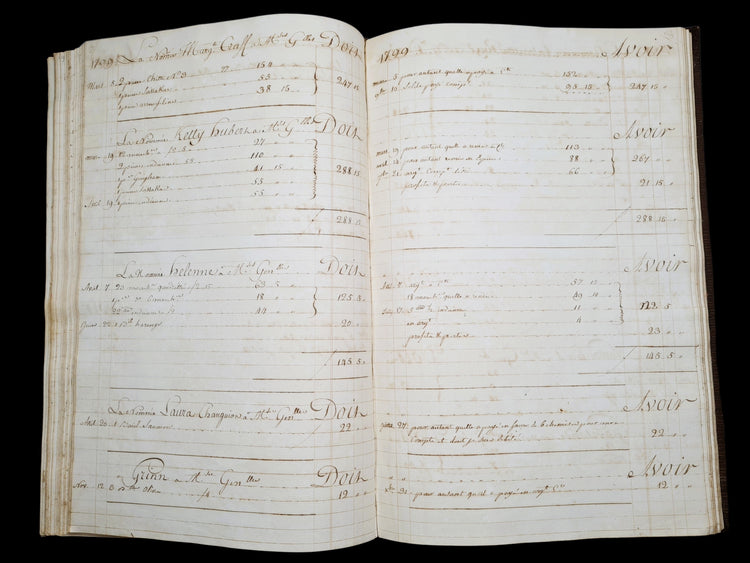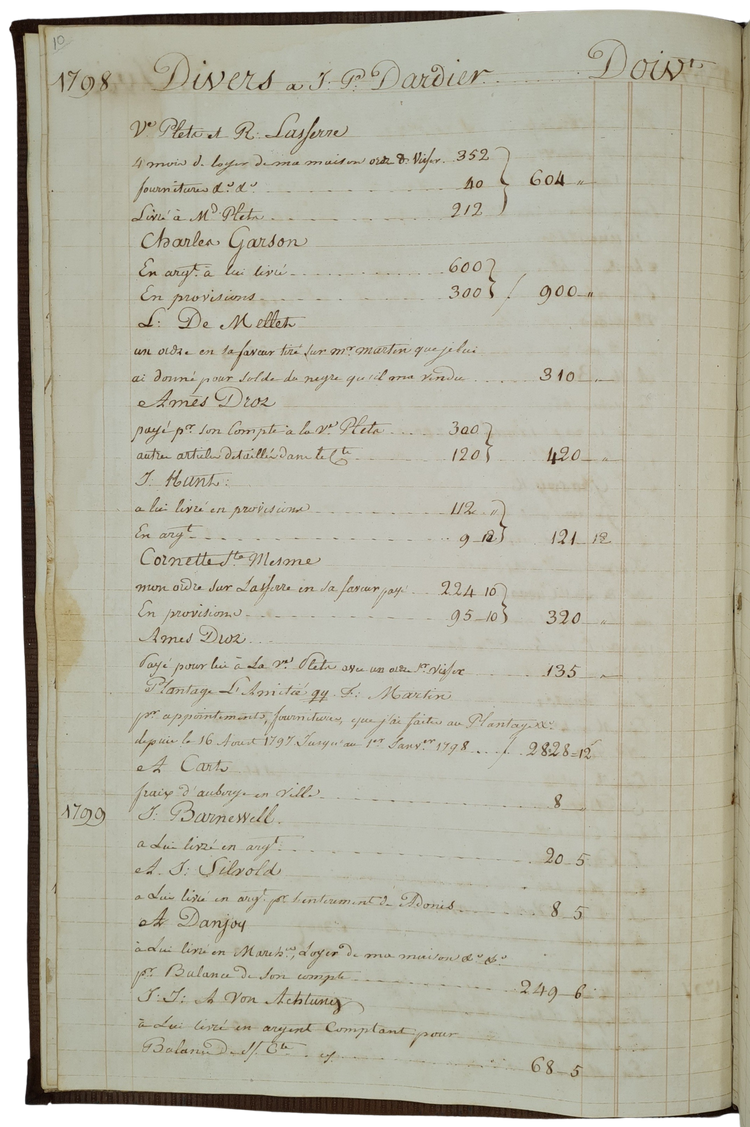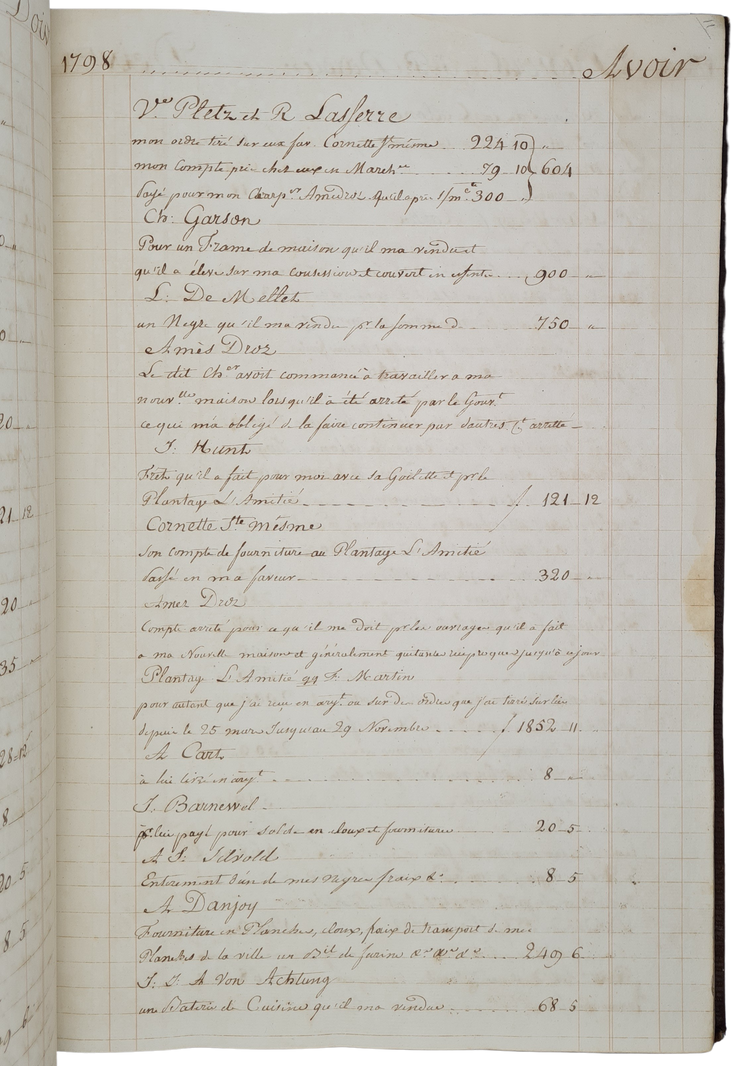Dardier, Account book, 1800.
- Regular price
- €19.000,00 EUR
- Regular price
-
- Sale price
- €19.000,00 EUR
- Unit price
- per
Slave trader and plantation director’s account book
J[ean] P[hilippe] Dardier.
[Account book].
[Mahaica, Dutch Demerara - British Rio Demerary (present Guyana)], 1786-1800.
Folio. 105 pp.; 30 ll. blank. Entirely ruled in ink, entries written in ink in highly legible medium seized French handwriting (about 35 lines per page). Accounts nominally organized in two columns: must and have. Paginated later in pencil.
Endpapers watermarked “J Whatman” 1794 and all other pages watermarked crowned fleur-de-lis 1798 and “T Stains”.
Contemporary reversed calf with smooth spine, blind-tooled double frame with garland on covers and spine, marbled edges.
Exceptional manuscript account book of Jean Philippe Dardier, a freelance plantation director and trader in domestic slaves and luxury goods to the plantation owners of the colony Demerary. The 105 pages of accounts give incredible insight into the social-economic relations between the plantation owners, about whom precious little is known, and the role of enslaved people in the colonial society and economy.
During the years that this manuscript encompasses, 1786-1800, the colony was first Dutch Demerara and changed in 1796 to British Rio Demerary. It was located at the northern coast of South America, along with the other plantation colonies Suriname, Essequibo Pomeroon and Berbice. The plantations grew cotton, coffee or sugar and relied heavily on the forced labour of enslaved people from Africa.
The accounts were kept in the first person by “J. P. Dardier”, about who we were unable to trace any secondary biographical information, though from related family names we can assume that his first names were Jean Philippe (see below). The account book provides a wealth of information about his private life and business in the colony. The 105 pages of accounts were kept for 14 years and are divided in two parts: personal and business. The watermark of the paper is dated 1798, so the accounts were made up retrospectively, at least in 1798 but most likely in the latest date in the book: 1800. The personal accounts tell us that he travelled in 1787 to Paris, then in 1788 to Middelburg in The Netherlands and in 1789 from there by ship to Dutch Demerara. These expenses were paid for by his uncle B. Dardier “de Paris”. Later on in the book he writes “Barth. Dardier de St. Gall”, which led us to identify him as Michael Barthelemy Dardier (1748-1833 St. Gallen, Switzerland). When J.P. arrived in Demerary he was received by another uncle: André Dardier, the owner of cotton plantation Leliendaal at the stretch of coast between the Demarara and Mahaica. This area counted 73 estates, all growing cotton, of which the Dardier family owned nr. 70 (see Alston).
Upon arrival he was able to take up the position of director at his uncle’s plantation and with this income he paid back his travel expenses. However, this only lasted for 7 months because André Dardier died in 1790, forcing Jean Philippe to work somewhere else. He took up the position of director at the nearby cotton plantation of “Chavalier Cornette” at “Canal no. 1” in 1790. We did not identify the name of this plantation but Cornette is indeed recorded as a plantation owner (see Alston). Jean Philippe continued to work there for a full year in 1791. Meanwhile he sells provisions to several other plantation owners and from 1792 he starts to trade in enslaved people, called “negres” and “nergrettes” in the book. Often they are distinguished as “negre domicile”, indicating that they were not intended to work the fields but in the house as servants. He buys a couple and then rents them out, a successful and lucrative practice that is repeated throughout the accounts. For this side business he rents houses from clients. In 1792 he took up a director position at the “Descaver” plantation of Bouisson freres & Mopinot and in 1793 he is transferred to the cotton plantation “l’Amitié” (nr. 35, at the coast). He continues to purchase enslaved people, some are named: “Eylinton”, “Pretent”, “Julienne”, “Anthony”. He continues to work at l’Amitié as director until the end of 1798 and he supplies undisclosed “proviand” and “marchantile” to dozens of planters. This steady income allowed him to invest in the purchase of enslaved people and eventually he buys a house, a kitchen, a cow and a horse. The house is located in Mahaica, the next creek east from the Demerary. From 1799 he resigns from plantation work and starts his business in the trade of luxury goods imported from France such as wine, fine linen, raisins, liquor, olive oil etc. This is all listed in detail per client in the second part of the account book, providing insight into the private lives of his clients: dozens of Dutch, British, French and German plantation owners and some American captains. Names often seem to be spelled phonetically, as if the accountant did not know the proper spelling. Customers pay with cash but sometimes in goods such as cotton, sugar or coffee. And once in a while luxury goods are paid for by selling an enslaved person. For example: Antoinette Ruyl paid her account for several fabrics with a transfer of ownership of a “negresse” woman named Méry, though this did not cover the whole bill…
This was a rough sketch based on the information in the account book; a much more detailed picture of plantation life in the Guyana colony can be made up from the vast information that this exceptional manuscript provides.
There is no mention of the full names of J.P. Dardier in the account book, but we found an English and a Dutch record of a John Philip Andrew Dardier, son of André Dardier, born in 1790 in Demerary. This is not “our” J.P. because he was already active in 1789 and not born in Demerary. However, the father André was the uncle of “our” J.P. Dardier, so probably J.P. stands for Jean Philippe. Multiple mentions of the town of St. Affrique in France suggest that he was from there (he named an enslaved servant “St. Affrique”…).
The 14 years that are covered in this account book coincide with a tumultuous era in the history of the colony. After English and French occupation it came back into Dutch possession in 1783 until the English again seized Dutch possessions in America in 1796. Control was returned to the Dutch after the Peace of Amiens (1802), but reoccupied by England a year later (1803), and formally ceded to Great Britain by the new Kingdom of the Netherlands on November 20, 1815. Reunited in 1814, the colonies of Essequibo and Demerara formed the nucleus of British Guiana (1831-1966). Today it the Co‑operative Republic of Guyana.
Provenance: Librairie Fabrice Teissèdre, Paris.
Condition: corners bumped, covers slightly soiled, thumbed at the side, otherwise strong and intact. Inside in very good condition.
Literature:
Alston, David. Plantation owners Demerara and Essequibo 1759 to 1823, University of Amsterdam library, open access Excel file.
For Michael Barthelemy Dardier see: https://doi.org/10.3931/e-rara-65577
The Essequebo and Demerary Gazette, 1805, no. 147.
Tikwis Begbie, British colonists index “D”. URL: https://www.vc.id.au/tb/bgcolonistsD.html, accessed 4-10-2022.
Walker, A Chart of Coast of Guyana, 1798.
Couldn't load pickup availability
Share







Contact
Email: hugo@artemrarebooks.com
Phone: +31651042297
Visit us on appointment at:
Former US Embassy
Lange Voorhout 102
2514EJ
The Hague (The Netherlands)
Shipping address:
Nannie van Wehlstraat 51
2548MN
The Hague
The Netherlands







